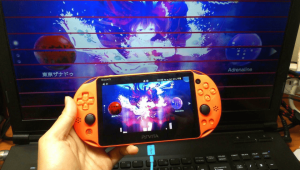More actions
| UDCD UVC | |
|---|---|
 | |
| General | |
| Author | xerpi |
| Type | Plugins |
| Version | 1.7 |
| License | Mixed |
| Last Updated | 2020/09/23 |
| Links | |
| Download | |
| Website | |
| Source | |
PSVita UDCD USB Video Class plugin (UDCD UVC) is a kernel plugin that lets you stream your PS Vita screen to your computer via USB.
Installation
Files:
- udcd_uvc.skprx - Doesn't turn the display on/off.
- udcd_uvc_oled_off.skprx - Turns the display on/off on OLED Vitas (Vita 1000).
- udcd_uvc_lcd_off.skprx - Turns the display on/off on LCD Vitas (Vita 2000).
How to install:
- Copy udcd_uvc.skprx to your PS Vita.
- Add udcd_uvc.skprx to taiHEN's config (ur0(ux0):tai/config.txt)
*KERNEL ur0:tai/udcd_uvc.skprx
User guide
How does it work
The plugin uses the SceUdcd module of the PS Vita OS to setup the necessary USB descriptors to simulate and behave as an USB Video Class device (like a webcam or an USB video capture card).
The hardware color space converter of the PS Vita's SoC is used to perform the conversion to the destination pixel format; then the USB controller directly performs a DMA transfer from the physical address of the resulting converted framebuffer, and therefore, saving CPU usage and power consumption.
Supported Formats and Resolutions
- 960x544 @ 30 FPS and (less than) 60 FPS
- 896x504 @ 30 FPS and (almost) 60 FPS
- 864x488 @ 30 FPS and 60 FPS
- 480x272 @ 30 FPS and 60 FPS
- 1280x720 @ 30 FPS
Troubleshooting
If the video looks glitched, try to change the video player configuration to use the NV12 format or switch to another player (like PotPlayer or OBS). If the colors look wrong, set color range to full and color space to BT.601 (Rec. 601).
If you use Windows 10 you might have to change the Camera access permissions on the Privacy Settings.
On Linux it is recommended using mpv (mpv tv:// --tv-device=/dev/videoX --tv-width=960 --tv-height=544) or mplayer (mplayer tv:// -tv driver=v4l2:device=/dev/videoX:width=960:height=544).
Audio noise fix - Disable USB power supply (Settings > System).
Note: Remember that if anything goes wrong (like PS Vita not booting) you can always press L at boot to skip plugin loading.
Note 2: No, it doesn't stream audio. For that use a 3.5mm jack to jack adapter (a ferrite bead might help reduce the electromagnetic noise).
Media
PS Vita Video Output Over USB - No New Hardware Needed (Blaine Locklair)
Changelog
v1.7
- Increase initial delay to 15s: should help fixing issues when a lot of plugins are loaded (UDCD UVC used to not work).
- Fix UVC payload size to be 12B as per UVC spec: should fix support on macOS and Android. Thanks to @xfangfang for spotting the issue.
v1.6
- Add frame descriptor for 1280x720 (with the Sharpscale plugin, the Vita is able to submit 1280x720 framebuffers to the kernel).
- Dynamically allocate memory for UVC frame: allocates only as much memory as needed and only when needed, otherwise with a 1280x720 buffer for the UVC frame, the kernel frequently runs out of memory.
- Minor code fixes.
v1.5
- Removed unused interrupt endpoint, which seems that allocated USB bandwidth that could not be used for sending the video data. Before this change, sending a 960x544 NV12 frame took ~16ms (plus ~2.5 for CSC), now that this endpoint is removed and more bandwidth is available, sending a frame takes ~13ms.
- Colorspace conversion takes ~2.5ms, therefore, now it takes 13+2.5 = 15.5ms to send a full frame, so 60FPS can be achieved at full resolution.
- Minor cleanups.
- Compiling with -O2.
v1.4
- Add OLED/LCD on/off support when connecting/disconnecting the USB (two different builds depending on OLED or LCD).
v1.3
- Fix System app detection thanks to @u3shit.
v1.2
- Fixed 480x272 support thanks to u/Kaizu_vita.
External links
- GitHub - https://github.com/xerpi/vita-udcd-uvc
- GBAtemp - https://gbatemp.net/threads/release-psvita-usb-streaming-uvc-usb-video-class.513997/page-2
- Reddit - https://www.reddit.com/r/vitahacks/comments/iy5ct1/release_v17_usb_streaming_udcd_uvc_fixes_macos/
- Reddit - https://www.reddit.com/r/vitahacks/comments/ad4xld/v12_psvita_usb_streaming_uvc_usb_video_class/
- VitaDB - https://vitadb.rinnegatamante.it/#/info/395
